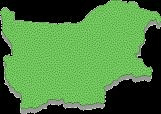|
|
A part of the historic geographical region Maesia. The area is 15,150 sq. km (13.8 % of the territory of the country). The Nikopol-Turnu Magurele ferry link operates between Bulgaria and Romania in the north. The south the boundary of the region follows the ridge of the Central Balkan Range. Communications with South Bulgaria use the three big mountain passes -
Troyan, Shipka and The Pass of the Republic.
The geographic features are very diverse. The northern and central part is dominated by flatland, and in the South by mountains. The climate is temperate continental, and combined with the fertile soils (chernozem,
gray forest soils) is suitable for the development of intensive farming agriculture. The water of the bigger rivers - Yantra, Rositsa, Vit and Osam - is used for drinking and irrigation. In order to preserve some valuable plant and fauna species some nature reserves have been created in the Southern mountainous area.
The population of Lovech region is 1,009,196 (11.9% of the population in the country). The urbanization processes going at a slower
paceed. The urban-rural population ratio is 64:36. There is ethnic homogeneity
as 95% are Bulgarians. The ethnic picture is rounded off by small groups of Gypsies, Wallachs (along the Danube), Armenians and Jews (in the bigger towns).
The economy of the region is diversely specialized. Most of the gross domestic product (50%) is generated by the branches of mining and processing industry - chemical industry
(Pleven, Gabrovo,
Veliko
Tarnovo), mechanical engineering and electrical engineering
(Gabrovo, Veliko
Tarnovo, Sevlievo), textile industry
(Gabrovo), food industry (Pleven Svishtov, Gorna Oryahovitsa). An interesting
ethnography museum in the open Etara near Gabrovo presents old crafts that were characteristic of the region in the past. Agriculture is determined by the soils and climate in the region. The
northern and in the central part grows cereals, industrial crops and vegetables. The southern hilly and
semi mountainous part has orchards (plums, pears) and vineyards. The enterprise mix is: cereals 56%, industrial crops 17%, vegetables 3%, and fodder crops 24%. The region manufactures 85% of the
electric engines in the country, 36% of the cement, 19% of the machine tools, 63% of the sugar, 17% of the meat products, 16% of the grape wines.
The administrative center of the region is Lovech with a population of 50,000. It has a central location. Preserved and restored are the old part of the town with interesting architecture, the covered bridge over the river Osam, many museums and monuments. The towns Pleven,
Gabrovo and Veliko
Tarnovo have greater demographic and economic potential.
Veliko
Tarnovo rises amphitheatrically on the two banks of the river Yantra and has eventful history. From the 12th to the 14th century the town was capital of the Second Bulgarian State. During this period a royal palace was erected on the hill Tsarevets. Part of the architectural monuments are conserved and preserved. The town Lyaskovets, one of the greatest vine growing and wine production centres in Bulgaria is very near to
Veliko
Tarnovo.
Gabrovo
is picturesquely located along the two banks of the river Yantra; it is a national
center of textile industry and electrical engineering and has a
Humor Museum. Pleven is the biggest industrial center in Central North Bulgaria and has many museums and cultural monuments, associated with Bulgarian history. In the southern part of the region the towns Teteven,
Troyan, Tryavna attract many tourists for who suitable
accommodation is provided.
|
